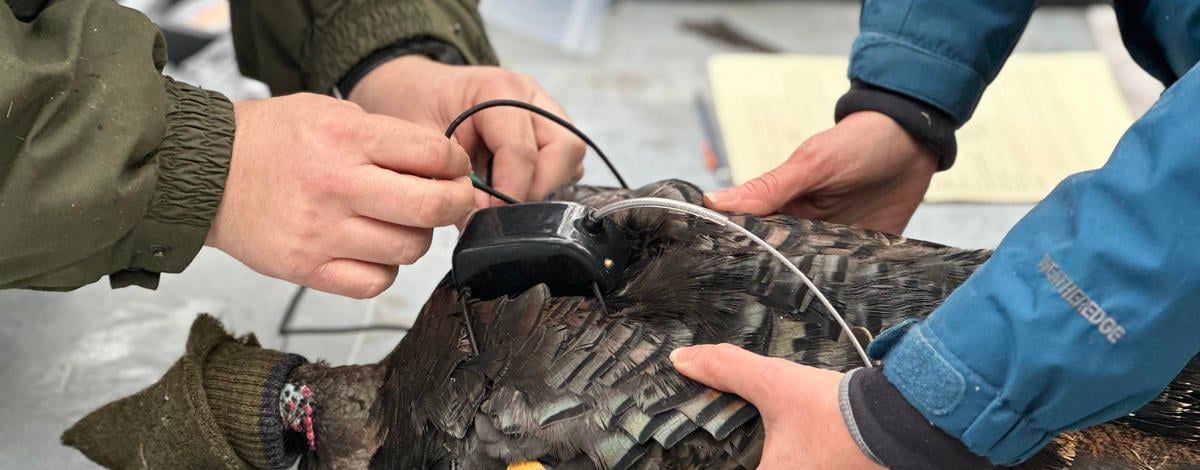Idaho begins studying turkeys north of Coeur d’Alene

Micah Ellstrom spent a good chunk of his winter chasing turkeys.
From December to early March, Ellstrom, a biologist with the Idaho Department of Fish and Game, baited walk-in traps in the woods north of Coeur d’Alene to attract turkeys so he could fit them with GPS backpacks.
The backpacks are attached to 30 hens in North Idaho. It’s all part of a new study looking at the birds’ nesting ecology. Over the next 20 months or so, the collars will send Ellstrom GPS signals telling him where the turkeys are.
He’ll use the data to figure out when and where turkeys are nesting. After the eggs hatch, he’ll visit the nests to learn about the gobblers’ habitat choices and the survival rate for newborn birds.
Backpack collars are in use for studies like this in other parts of the country, but it’s a new approach for North Idaho. The work is starting at a particularly good time to start learning more about the region’s turkeys, too.
In parts of the South and the Midwest, turkey populations have been in steep declines, prompting some states to reduce hunting opportunities.
Meanwhile, parts of the West, such as Idaho and northeast Washington, have been bucking the trend, reporting healthy and robust populations of the non-native birds – enough of them to annoy city dwellers and thrill avid hunters.
In the Idaho Panhandle, Ellstrom said they believe their turkey population has been growing in size over the past 10 years.
“There are plenty of turkeys,” Ellstrom said. “It’s a pretty good time to be a turkey hunter in North Idaho.”
He added that studying birds while the population is doing well will help them manage the birds better if the trend ever reverses.
“Now was kind of a good time to start collecting some of these baseline data,” he said.
Wild turkeys aren’t native to the Inland Northwest. In Washington, attempts to establish turkey populations began more than 100 years ago, though sustainable breeding populations didn’t take hold until the 1960s.
Since then, they’ve done well, particularly in northeast Washington.
“They just seem to thrive up here,” said Annemarie Prince, a biologist for the Washington Department of Fish and Wildlife based in Chewelah.
In Idaho, turkey transplants began in 1961 and continued through 2008. More than 6,200 of the birds were released.
All three species – Eastern, Rio Grande and Merriam’s – were introduced, but about 4,000 of the birds were Merriam’s. That species has been the most successful, according to Idaho Fish and Game, and they’re widely distributed. Talk of their numbers usually happens in generalizations, because the birds are hard to count. Most of the information wildlife biologists have comes from hunters reporting their kills, not organized surveys.
Prince said WDFW stopped doing regular counts years ago because it wasn’t sure the surveys – essentially driving around and counting turkeys – were providing useful information. She said WDFW might consider restarting surveys if it has a model in which they’re confident.
The agency hasn’t used backpack collars on turkeys, but she said Idaho’s nesting ecology study will add to the region’s understanding of the gobblers.
“I imagine whatever Idaho finds out will be applicable to us,” Prince said.
Mild winter conditions made trapping turkeys somewhat challenging for Ellstrom – the birds don’t need to eat bait when they have plenty of other options – but he eventually handled enough birds to get the collars out.
The collars go over the wings and the GPS units sit on the gobblers’ backs. The collars send signals multiple times a day telling him where the birds are, and once he sees that they aren’t moving, he’ll know they’ve selected a nest.
He’s interested in where the nest is and when the turkeys decide to nest and lay eggs. When he goes to look at the nests, he’ll be trying to determine how many eggs were laid and whether predators attacked any of the nests.
Through the course of trapping the birds, Idaho Fish and Game also fitted turkeys with leg bands, a common practice for keeping track of individual birds. Though only the hens got GPS collars, all the birds Ellstrom handled got bands, and now there are more than 120 banded gobblers in the panhandle.
The agency is asking any hunter who takes a banded bird to report it to the Panhandle office in Coeur d’Alene. Each report will be another piece of data that will help biologists understand the turkeys of North Idaho.